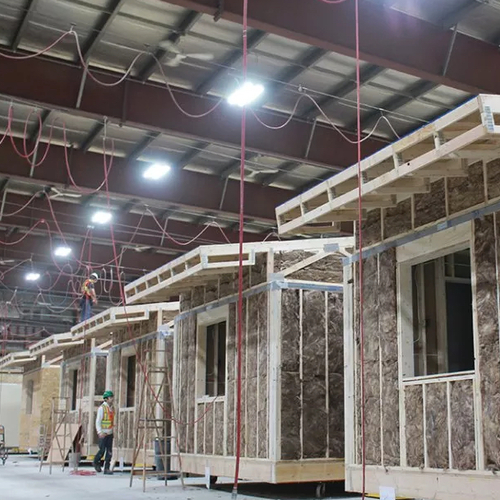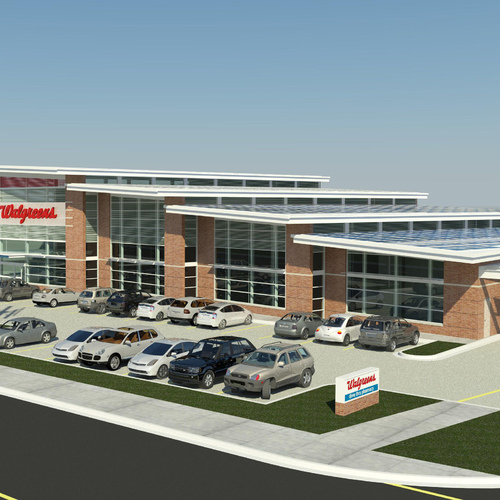Image Credit: Active House USA
Image Credit: Active House USA The stairwell adjacent to the kitchen was designed specifically to bring light into the core of the house, including the basement. Daylighting is a key component of the Active House specification.
Image Credit: Active House USA The house at Webster Groves has proved popular during two open houses. Most recently, more than 2,000 people took a look over a two-day stretch. A pre-drywall tour attracted 800 visitors.
Image Credit: Active House USA The house as it appeared in January. The new owners are expected to move in this spring.
Does the U.S. need another green-building standard?
St. Louis builder Matt Belcher and the Active House Alliance, a consortium of European firms led by Velux, are hoping so, and a nearly complete 2,500-sq. ft. house in a St. Louis suburb will be its U.S. debut.
Active House is a two-year-old program launched in Brussels that promotes the construction of houses that are energy-efficient, comfortable to live in, and positive for the environment.
Those goals seem in line with green-building programs already established here, including LEED for Homes, the National Green Building Standard and even Passivhaus. Yet the consortium apparently sees enough differences in these competing approaches to press ahead.
Active House certification requires third-party verification, and relatively few of them have been built. Green Building Advisor contributor Richard Defendorf profiled one Active House built in Russia in a 2011 blog. The Alliance also lists a number of ”Active House cases” at its web site.
Construction of the house in Webster Groves, not too far from the center of St. Louis, is the start of efforts by the European consortium to extend its reach here.
What the Active House standard looks like
The 1st edition of the Active House specification (subtitled “buildings that give more than they take”) is a 44-page document that can be downloaded from the alliance’s web site in either English or German.
It lays out a number of “key principles” in three areas:
- Energy. Buildings should be energy efficient, “easy to operate,” exploit a number of energy sources and “substantially” exceed minimum energy standards.
- Indoor climate. In addition to high indoor air quality, the house interior should promote “health, comfort and sense of well-being.” It should also be easy for occupants to control.
- Environment. Houses should have minimal impact on the environment, “add to local biodiversity” and be constructed of materials with a high recycled content.
“Active House proposes a target framework for how to design and renovate buildings that contribute positively to human health and wellbeing by focusing on the indoor and outdoor environment and the use of renewable energy,” the document’s introductory section explains. “An Active House is evaluated on the basis of the interaction between energy consumption, indoor climate conditions and impact on the external environment.”
The web site lists a number of alliance partners as well as its board of directors. The chairman is Mikkel Skott Olsen of Velux.
Like other green-building initiatives, this one lists measurable objectives in a number of areas. Annual energy use, for example, must be 30 kWh or less per square meter per year to hit the top of four rankings (that’s double the amount allowed under the Passivehaus standard). Houses that produce all of the energy they need on site get a no. 1 ranking in the energy supply section, or a no 2 ranking if they produce more than 50% of the energy they use. There also are goals for the amount of daylight the buildings take advantage of, maximum and minimum indoor temperatures, and maximum permissible carbon dioxide levels.
Active House comes to America
The new house at the corner of Gray and West Swon Avenues in Webster Groves is the work of Belcher’s firm, his frequent collaborator Kim Hibbs of Hibbs Homes, architect Jeff Day and several others. But it really started when Velux got in touch with Belcher and asked him whether he’d be interested in building the first Active House on this side of the Atlantic.
The company found him, Belcher says, through its network of Velux dealers here, and Belcher flew to Charleston to meet with alliance officials. With a number of green-building projects already under his belt, Belcher thought an Active House project would be a good fit, even if early Active Houses tended toward modern designs.
“I felt confident to build to these levels,” he says, “but also knowing what price point we’d be at I kind of knew we’d be in the inner suburbs of St. Louis and I also knew their architectural review boards were not going to let me build an ultra-modern looking house in these old neighborhoods. [Active House] was fine with that, and in fact they came to really like the idea that we had to design for an infill house and make it an Active House.”
Belcher and Hibbs approached Day, with whom they’d worked in the past, and began looking for a likely client. That turned out to be David Smith, a local accountant, who’d hired Day to design a remodel for him in the past. Smith had contacted Day to tell him he was thinking of building a new house.
“And Jeff says, ‘Have I got the perfect project for you,’” Belcher says. “David’s a CPA and 10 minutes into the conversation he got the economics of it. It was a slam-dunk.”
What Smith and his young family got was a two-story bungalow-style house made with structural insulated panels (R-25 walls and R-45 roof) for about $500,000, or $200 a square foot. It’s heated with a 98% efficient gas furnace, cooled with a SEER 20 air conditioning unit and serviced by an energy-recovery ventilator, Belcher says. It has 4.88 kW worth of photovoltaic panels on the roof, and solar collectors for domestic hot water.
“People ask about the cost of the equipment to make it perform and that probably added about 7% total to the cost of the house,” Belcher says. “But the upgrades in tile, high-end hardwood and all that stuff probably added 10%. So it’s kind of relative to the construction costs of the house. People get the wrong idea of what those [performance] upgrades are.”
Active House liked the fact the house would be an infill project, and also because of the St. Louis climate.
“One of the things that became appealing to the Active House Alliance was that we heat half the year and cool half the year,” Belcher says. “We’re in a mixed humid climate zone, so we have to build for both extremes, plus we’re in tornado alley, and in the New Madrid seismic zone. We’re building bunkers that look like houses.”
The house, described in an article in the St. Louis Post-Dispatch, will get a blower-door test later in March, as well as equipment allowing performance monitoring, before the Smiths move in. The project also has its own web site, which includes a project description, background on the Active House initiative, and more photographs of the project.
The house replaces an 80-year-old bungalow on the lot that was in poor repair. Belcher says they deconstructed the house, diverting 50 tons of materials from landfills and supplying a local Habitat ReStore outlet with windows and other materials.
What makes Active House different?
Matt Belcher’s selection to spearhead the Active House movement in the U.S. might seem a little ironic. Among his many professional connections is a seat on the board of directors of the National Association of Home Builders, which helped to develop the National Green Building Standard (also known by its more formal moniker, ASNI-ICC 700). Belcher, in fact, is chairman of NAHB’s green-building subcommittee.
But Belcher’s close association with the ICC-700 has done nothing to dim his enthusiasm for this one. The Webster Groves project is designed to qualify for a number of sustainable-building designations, including Energy Star, Building America Builders Challenge, and the National Green Building Standard.
Belcher says the Active House standard could work in tandem with other green-building initiatives like NGBS, not necessarily replace them. “I view them as complementary, and expanding my marketing message,” he says. He adds that Active House is “quite similar” to ICC-700 in that it takes a “holistic” approach to building design.
But the Active House specification, he says, puts more emphasis on daylighting and other design features that make a house healthy and comfortable.
“I tell you what I like about Active House,” Belcher says, “and, again, I’m chair of NBH’s green building subcommittee, and a big believer in the National Green Building Standard because it’s a great specification. What I like about Active House is the fact that one of their main goals was occupant comfort.
“I’m concerned some of the programs out there are more about the building than the occupant,” he says. “Obviously, we need to have high performance buildings but we can’t forget who’s going to live in those houses, either.”
Belcher also is getting a kick out of helping to develop the specification.
“Besides being involved in assisting with the development of their specification, which is cool, interacting with building codes and science geeks like me from many other countries is very cool,” he says. Whether the process translates into a program that North American builders and buying public embrace, however, remains to be seen.
“The jury’s still out, frankly,” Belcher says.
Weekly Newsletter
Get building science and energy efficiency advice, plus special offers, in your inbox.
















5 Comments
Velux?
Velux makes skylights. They make really excellent skylights. But they're still skylights, and from the picture above it's obvious that they've put a lot of holes in the roof to accommodate them. So it seems a bit suspicious that they are promoting a "green building" standard. I don't see how all those skylights are going to add up to increased energy efficiency. I've always regarded them as slick and cool, but inherently inefficient in terms of energy usage. They may save a bit on lighting costs, but it gets damned hot and humid in St Louis in the summer. So you crank up the AC to deal with the solar gain from the skylights, and in the winter you lose heat through the glass in the roof. It's kind of like Godiva chocolates sponsoring a weight loss program.
Siding
What is the siding material on this house?
RE:Velux
Velux (Europe) also has(had) solar panels, solar hot water and various other building products.
Siding
Matt Belcher says the siding is pre-finished fiber cement manufactured by James Hardie.
A classic greenwashing!
Hip roofs are the architectural equivalent of tail fins. It ought to be editorial policy for GBA to reject any article that doesn't feature a gable roof with an east-west orientation because that is the single most important factor in green building. You can go back and fix bad insulation or air sealing or mechanicals, but inappropriate roof design is something that will never be fixed.
Even worse are all the skylights: Bad enough they face south which substantially increases heat gain (with the bonus of adding harsh glare to the insides), but it makes the PV installation a nightmare because it makes it impossible to build on a robust framework (photos on other sites show it's a veritable checkerboard). Add insult to injury by making mention of tornado exposure: This place needs a new roof and PV system the first one they have. Maybe then they can get rid of all the skylights and replace the environmentally-heinous asphalt shingles with standing seam metal onto which you can directly mount the PV (or thermal) system for a low-profile and tornado-proof install.
Log in or create an account to post a comment.
Sign up Log in